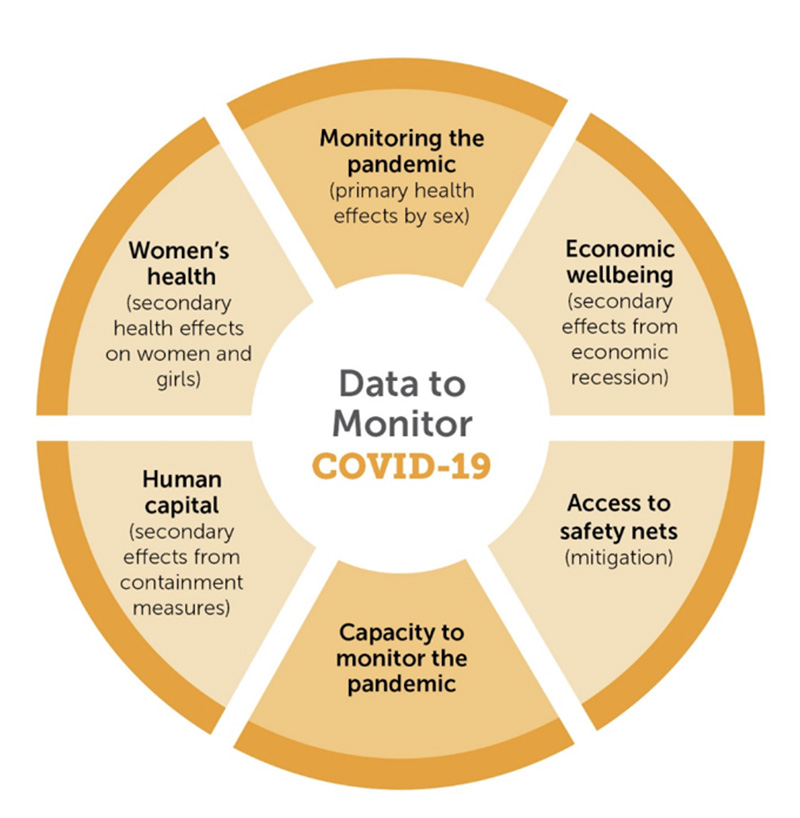This article was originally published by the Center for Global Development.
How well can we track the gender impacts of COVID-19?
The answer, unfortunately, is very imperfectly, as a joint Data2X and Open Data Watch ongoing review of the principal international databases is finding out. We know that the coronavirus pandemic is affecting men and women differently and may exacerbate gender inequalities, and we also know that gender roles will help shape adaptive responses to the pandemic. But do we have the granular information that is needed (on regions, sectors, coverage, and severity) to design effective, gender-informed mitigation and recovery policies? To answer this question, we identified possible primary and secondary gender effects of the pandemic based on analyses of gender impacts of past pandemics and other aggregate shocks such as disasters, economic crises, and violent conflicts. The pandemic has primary effects on health and secondary effects on health, social, educational, and economic dimensions from the containment measures implemented and the ensuing economic contraction. Effects will vary with sex, age, and race as well as other characteristics of socially excluded groups (Figure 1 – see above). We selected 28 basic indicators to track these primary and secondary effects as well as mitigation and adaptive responses, and we searched the principal international databases maintained by the United Nations, WHO, ILO, UNESCO, UNICEF, and the World Bank for the availability of sex-disaggregated data by country. These sources are highly standardized, and the available data generally conform to well-documented methodologies, making the data comparable across countries and over time. For most of the secondary effects, trends over time (before and after the pandemic) are needed to assess gender differentials, so we also checked the frequency of years with data since 2015 to be able to compare the effects of the pandemic with “before” trends that are recent enough.Summarized, our initial findings show that:
- The data to track primary health effects by sex on cases and deaths is incomplete for the majority of the global population, non-existent for low-income countries, and unavailable for health care workers, except for a handful of countries. Even upper-middle and high-income countries such as Brazil and the United States have trouble reporting infection rates by sex (although they report deaths by sex).
- The lack of recent data is a problem for most indicators to track secondary effects, as is the regularity with which they are reported since 2015.
- There is adequate data to track secondary health effects on maternal health and adolescent births, but inadequate data to document effects on domestic violence and the wellbeing of girls. The data on women’s mental health have adequate coverage and frequency but are based on estimates with large gaps in underlying data.
- The economic indicators are less than adequate to track the secondary effects of the pandemic on economic wellbeing by gender. Neither job losses nor increases in unpaid care work by sex can be fully monitored with the available data. In contrast, sex-disaggregated education indicators are most abundant with available time series.
- Indicators like social protection coverage, personal ID coverage, and mobile phone ownership, which can monitor whether short-term mitigation measures exacerbate pre-existing gender inequalities, have been incorporated only recently into international datasets and have low coverage. This is a significant data gap in need of immediate attention.
- Gaps in frequency and timeliness for the majority of indicators we selected to track the gender effects of the pandemic are greater for rich than for poor countries, constraining rich countries’ abilities to monitor the effects of the pandemic on gender inequalities.
What does this mean?
This initial analysis demonstrates how little internationally comparable data currently exist to inform our understanding of the gendered implications of the pandemic. This finding — that we don’t have enough data on COVID-19 — is not new, but identifying the specific areas where data are missing is new territory that we believe is important to explore. By identifying these areas, we hope to stimulate efforts that will help fill data gaps and ensure communities have the resources they need in the fight against COVID-19. The next steps for this collaboration are to use the insights above to find solutions to COVID-19 gender data gaps. Stay tuned! Read our technical brief to explore these initial findings in more detail. Note: this blog post originally appeared on Data2X’s website.DISCLAIMER
CGD blog posts reflect the views of the authors, drawing on prior research and experience in their areas of expertise. CGD is a nonpartisan, independent organization and does not take institutional positions.
Photo credit for social media: Data2X


